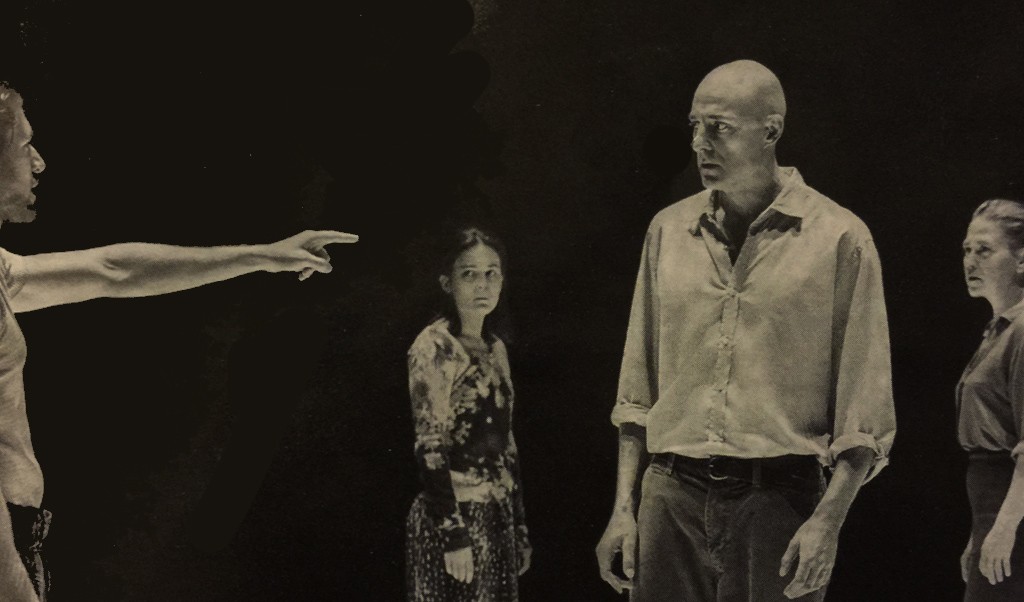To See or Not to See: A View from the Bridge

The newest revival of Arthur Miller’s A View from the Bridge is one of the current British imports to Broadway. Directed by Ivo van Hove, this production–along with it’s original British cast– transferred to Broadway from a highly acclaimed run on London’s West End. Having missed the most recent Broadway revival a few years ago (starring Liev Schrieber and Scarlett Johansson), I was curious to see this unique take on a classic play.
For anyone not familiar with the play, a quick overview: Eddie Carbone is a longshoreman working and living in Red Hook, Brooklyn. He lives with his wife, Beatrice, and their niece, Catherine, whom they have raised since she was little and is now a young woman. Beatrice’s two nephews, Marco and Rodolpho, come over illegally from Sicily to find work and stay with the Carbonne family. Marco has a family back in Italy to whom he is sending the money he makes from working the shipyards; Rodolpho is single and excited to be in New York City. Naturally, Catherine and Rodolpho begin spending time together…much to Eddie’s dismay. Is Eddie protective of Catherine as a relative would be, or does he have a subconscious desire for her that are making him irrational?
The acting was mostly stupendous. Mark Strong embodied Eddie Carbone. He radiated strength and masculinity. He was intense and righteous in what he believed to be morally correct while staying willfully ignorant of his true desires. Nicolla Walker was intelligent and sharp in her portrayal of Beatrice. You could feel her trapped as a housewife, struggling to subtly take care of a tricky situation. Where Eddie was ignorant, Beatrice was not. Mark Gould as Mr. Alfieri, the lawyer acting as narrator of this play, was sadly resigned to the fate he knew was waiting for Eddie. Every other actor was decent in their roles. I couldn’t help but imagine what Scarlett Johansson would have been like as Cathy—a much more believable desirable young woman than Phoebe Fox. Fox’s Cathy came across as dumb and too childish. Additionally, Russell Tovey was an adequate Rodolpho. He seemed a bit silly at times, and the chemistry between Tovey and Fox was very lacking.
The set design was incredibly minimalist—a white floor with black plexiglass benches fencing it in with one doorway that seemed to lead into a dark abyss. There were no props at all. The lack of props made some parts slightly confusing. A scene in which the longshoremen are to have “dropped” a box of whisky and drank it amongst themselves is but a line uttered by Alfieri. If you missed that moment, you may not pick up on the fact that Eddie is drunk when he confronts Catherine and Rodolpho. That moment is pivotal in the final chain of events. Another scene which could have used some props was one when, in the original script, everyone is seated around a dinner table. In this production, however, everyone is sitting scattered across the stage, isolated. Their dialogue is stilted and doesn’t immediately make sense when there is no context as to where they are.
The costuming was also somewhat minimal in approach. Costume changes happened only twice: once, at the beginning when Eddie and Louis (his coworker and friend) are on stage. They are showering and changing into the costumes they will wear for the entirety of the show. The second costume change happens when Catherine changes her shirt toward the end of the play. Throughout the show, everyone is dressed in clothes that could be worn today, but that also evoke the era the play is set in (1950s Brooklyn): pants, button down shirts, pencil skirts, etc. The effect it creates is one of timelessness. One quirk, however, is that the actors within the box (that the plexiglass bench staging has created) are always barefoot as if to mimic a boxing ring. Indeed, the characters are all circling each other, waiting for the final fight.
Lastly, the sound design also helped create the sense of a fight. Steady drum beats, low and tolling, created a sense of doom and dread throughout the play. Moments of climax were accompanied by almost operatic music reminding me of grand Italian tragedies. At times, though, the sound was a bit distracting from the dialogue.
The final image we are left with at the conclusion will be seared in my memory–a literal bloodbath leaving no one untouched. While the minimalist approach may not appeal to everyone, the precision of each production choice and the strength of Mark Strong’s acting make this a production one to watch.


[…] that force audiences to focus on the actors and the dialogue (i.e. the recent Broadway revival of A View from the Bridge). In The Crucible, however, the set is a very detailed. The show’s only set is a Catholic […]